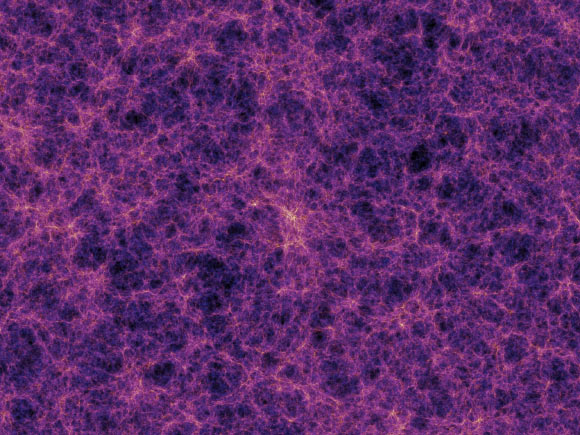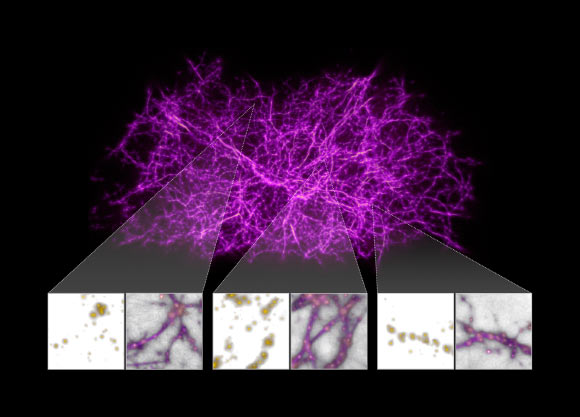Astronomers Use Slime Mold to Reveal Cosmic Web’s Dark Threads | Astronomy – Sci-News.com
Physarum polycephalum, a single-cell organism known as slime mold, builds complex web-like filamentary networks in search of food, always finding near-optimal pathways to connect different locations. In shaping the Universe, gravity builds a vast cobweb-like structure of filaments tying galaxies and clusters of galaxies together along invisible bridges of gas and dark matter hundreds of millions of light-years long. There is an uncanny resemblance between the two networks, one crafted by biological evolution, the other by the primordial force of gravity.

In shaping the Universe, gravity builds a vast cobweb-like structure of filaments tying galaxies and clusters of galaxies together along invisible bridges hundreds of millions of light-years long. This is known as the cosmic web. Image credit: Burchett et al.
According to the prevailing theory, as the Universe evolved after the Big Bang, matter became distributed in a web-like network of interconnected filaments separated by huge voids.
Luminous galaxies full of stars and planets formed at the intersections and densest regions of the filaments where matter is most concentrated.
The filaments of diffuse hydrogen gas extending between the galaxies are largely invisible, although astronomers have managed to glimpse parts of them.
None of which seems to have anything to do with Physarum polycephalum, typically found growing on decaying logs and leaf litter on the forest floor and sometimes forming spongy yellow masses on lawns.
But slime mold has a long history of surprising scientists with its ability to create optimal distribution networks and solve computationally difficult spatial organization problems.
In one famous experiment, slime mold replicated the layout of Japan’s rail system by connecting food sources arranged to represent the cities around Tokyo.
Dr. Joe Burchett, a postdoctoral researcher at the University of California, Santa Cruz, and colleagues turned to slime mold to help them build a map of the filaments in the local Universe — within 100 million light-years of Earth — and find the gas within them.
The researchers designed a computer algorithm, inspired by the behavior of slime mold, and tested it against a computer simulation of the growth of dark matter filaments in the Universe.
They then applied the slime mold algorithm to data containing the locations of over 37,000 galaxies mapped by the Sloan Digital Sky Survey. The algorithm produced a 3D map of the underlying cosmic web structure.
“That was kind of a Eureka moment, and I became convinced that the slime mold model was the way forward for us,” Dr. Burchett said.
“It’s somewhat coincidental that it works, but not entirely. A slime mold creates an optimized transport network, finding the most efficient pathways to connect food sources. In the cosmic web, the growth of structure produces networks that are also, in a sense, optimal. The underlying processes are different, but they produce mathematical structures that are analogous.”

Burchett et al designed a computer algorithm, inspired by slime mold behavior, and tested it against a computer simulation of the growth of dark matter filaments in the Universe. Image credit: NASA / ESA / J. Burchett and O. Elek, University of California, Santa Cruz.
The team analyzed the light from 350 faraway quasars catalogued in the Hubble Spectroscopic Legacy Archive. These distant cosmic flashlights are the brilliant black-hole-powered cores of active galaxies, whose light shines across space and through the foreground cosmic web.
Imprinted on that light was the telltale signature of otherwise invisible hydrogen gas that the team analyzed at specific points along the filaments.
These target locations are far from the galaxies, which allowed the research team to link the gas to the Universe’s large-scale structure.
“It’s really fascinating that one of the simplest forms of life actually enables insights into the very largest-scale structures in the Universe,” Dr. Burchett said.
“By using the slime mold simulation to find the location of the cosmic web filaments, including those far from galaxies, we could then use the Hubble’s archival data to detect and determine the density of the cool gas on the very outskirts of those invisible filaments.”
The survey further validates research that indicates intergalactic gas is organized into filaments and also reveals how far away gas is detected from the galaxies.
The astronomers were surprised to find gas associated with the cosmic web filaments more than 10 million light-years away from the galaxies.
But that wasn’t the only surprise. They also discovered that the ultraviolet signature of the gas gets stronger in the filaments’ denser regions, but then disappears.
“We think this discovery is telling us about the violent interactions that galaxies have in dense pockets of the intergalactic medium, where the gas becomes too hot to detect,” Dr. Burchett said.
The results were published in the Astrophysical Journal Letters.
_____
Joseph N. Burchett et al. 2020. Revealing the Dark Threads of the Cosmic Web. ApJL 891, L35; doi: 10.3847/2041-8213/ab700c





